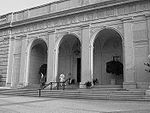Jamie L. Whitten Building

The U.S. Department of Agriculture Administration Building, also known as the Jamie L. Whitten Building, houses the administrative offices of the U.S. Department of Agriculture in Washington, D.C. The Administration Building projects into the National Mall from the larger U.S. Department of Agriculture South Building, and is the only building on the Mall that is not intended for use by the general public. It was the first large Beaux-Arts style building in Washington and set the prototype for the later buildings of the Federal Triangle. The east and west wings were the first Federal office buildings to be built of reinforced concrete. The Whitten Building was listed on the National Register of Historic Places in 1974.
Excerpt from the Wikipedia article Jamie L. Whitten Building (License: CC BY-SA 3.0, Authors, Images).Jamie L. Whitten Building
Jefferson Drive Southwest, Washington
Geographical coordinates (GPS) Address Website External links Nearby Places Show on map
Geographical coordinates (GPS)
| Latitude | Longitude |
|---|---|
| N 38.888055555556 ° | E -77.03 ° |
Address
Jamie L. Whitten Building (Jamie Whitten Bldg.)
Jefferson Drive Southwest
20250 Washington
District of Columbia, United States
Open on Google Maps










